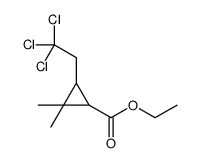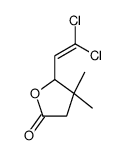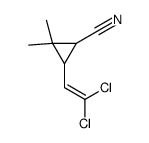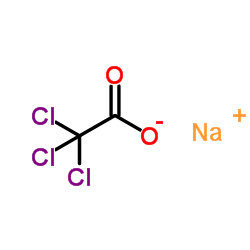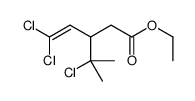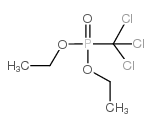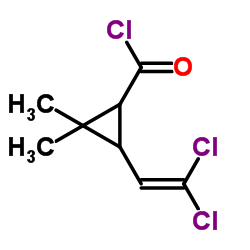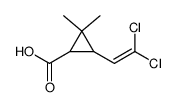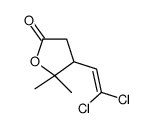59609-49-3
| 中文名 | 二氯菊酸乙酯 |
|---|---|
| 英文名 | Ethyl 3-(2,2-dichlorovinyl)-2,2-dimethylcyclopropanecarboxylate |
| 英文别名 |
ethyl 2,2-dimethyl-3-(2',2'-dichlorovinyl)-cyclopropane-carboxylate
3-(2,2-dichloroacetyl)-4-hydroxy-1-methyl-1,2-dihydroquinolin-2-one 2-(2',2'-dichlorovinyl)-3,3-dimethylcyclopropanecarboxylic acid ethyl ester 2,2-dimethyl-3-(2',2'-dichlorovinyl)-cyclopropanecarboxylic acid ethyl ester (3-phenoxyphenyl)methyl 2,2-dimethyl-3-(2,2-dichlorovinyl)cyclopropanecarboxylate EINECS 261-826-7 ethyl 3-(2',2'-dichlorovinyl)-2,2-dimethylcyclopropane-1-carboxylate 3-Dichloroacetyl-4-hydroxy-1-methyl-2-oxo-1,2-dihydroquinoline (3-phenoxyphenyl)methyl (1RS)-cis,trans-3-(2,2-dichloroethenyl)-2,2-dimethylcyclopropanecarboxylate ethyl 2,2-dimethyl-3-(2,2-dichloro-1-ethenyl)cyclopropanecarboxylate m-phenoxybenzyl (RS)-cis,trans-3-(2,2-dichlorovinyl)-2,2-dimethylcyclopropanecarboxylate 3-(2,2-dichloroacetyl)-4-hydroxy-1-methylquinolin-2(1H)-one 3-(2,2-dichloroacetyl)-2-hydroxy-1-methylquinolin-4-one 3-(2,2-Dichloro-vinyl)-2,2-dimethyl-cyclopropane-1-carboxylic acid ethyl ester 3-(2,2-dichloroethenyl)-2,2-dimethylcyclopropanecarboxylic acid (3-phenoxyphenyl)-methyl ester 3-phenoxybenzyl (1RS)-cis-trans-3-(2,2-dichlorovinyl)-2,2-dimethylcyclopropanecarboxylate |
| 密度 | 1.263g/cm3 |
|---|---|
| 沸点 | 239.3ºC at 760 mmHg |
| 分子式 | C10H14Cl2O2 |
| 分子量 | 237.12300 |
| 闪点 | 93.5ºC |
| 精确质量 | 236.03700 |
| PSA | 26.30000 |
| LogP | 3.14070 |
| 折射率 | 1.545 |
| 稳定性 | 二氯菊酸乙酯为无色透明液体,b.p.93~94℃/101pa,78~88℃/27pa,n20D 1.4833,相对密度 1.1170,不溶于水,溶于苯、甲苯、氯仿等有机溶剂。 |
| 分子结构 | 1、 摩尔折射率:50.19 2、 摩尔体积(cm3/mol):155.6 3、 等张比容(90.2K):389.7 4、 表面张力(dyne/cm):39.3 5、 极化率(10-24cm3):19.89 |
| 计算化学 | 1.疏水参数计算参考值(XlogP):无 2.氢键供体数量:0 3.氢键受体数量:2 4.可旋转化学键数量:4 5.互变异构体数量:无 6.拓扑分子极性表面积26.3 7.重原子数量:14 8.表面电荷:0 9.复杂度:267 10.同位素原子数量:0 11.确定原子立构中心数量:0 12.不确定原子立构中心数量:2 13.确定化学键立构中心数量:0 14.不确定化学键立构中心数量:0 15.共价键单元数量:1 |
Synonym: Section 2 - COMPOSITION, INFORMATION ON INGREDIENTS
Risk Phrases: 36/37/38 Section 3 - HAZARDS IDENTIFICATION EMERGENCY OVERVIEW
Irritating to eyes, respiratory system and skin. Potential Health Effects The toxicological properties of this material have not been investigated. Use appropriate procedures to prevent opportunities for direct contact with the skin or eyes and to prevent inhalation. Section 4 - FIRST AID MEASURES Eyes: Flush eyes with plenty of water for at least 15 minutes, occasionally lifting the upper and lower lids. Get medical aid immediately. Skin: Get medical aid. Flush skin with plenty of soap and water for at least 15 minutes while removing contaminated clothing and shoes. Remove contaminated clothing and shoes. Ingestion: If victim is conscious and alert, give 2-4 cupfuls of milk or water. Get medical aid immediately. Inhalation: Get medical aid immediately. Remove from exposure to fresh air immediately. If not breathing, give artificial respiration. If breathing is difficult, give oxygen. Notes to Physician: Treat symptomatically and supportively. Section 5 - FIRE FIGHTING MEASURES General Information: As in any fire, wear a self-contained breathing apparatus in pressure-demand, MSHA/NIOSH (approved or equivalent), and full protective gear. During a fire, irritating and highly toxic gases may be generated by thermal decomposition or combustion. Extinguishing Media: Use agent most appropriate to extinguish fire. Autoignition Temperature: Not available. Flash Point: 110 deg C ( 230.00 deg F) NFPA Rating: Not published. Explosion Limits, Lower: Not available. Upper: Not available. Section 6 - ACCIDENTAL RELEASE MEASURES General Information: Use proper personal protective equipment as indicated in Section 8. Spills/Leaks: Clean up spills immediately, observing precautions in the Protective Equipment section. Section 7 - HANDLING and STORAGE Handling: Wash thoroughly after handling. Remove contaminated clothing and wash before reuse. Avoid contact with eyes, skin, and clothing. Avoid ingestion and inhalation. Storage: Store in a cool, dry place. Keep container closed when not in use. Section 8 - EXPOSURE CONTROLS, PERSONAL PROTECTION Engineering Controls: Use process enclosure, local exhaust ventilation, or other engineering controls to control airborne levels. Personal Protective Equipment Eyes: Wear chemical goggles. Skin: Wear appropriate protective gloves to prevent skin exposure. Clothing: Wear appropriate protective clothing to minimize contact with skin. Respirators: A respiratory protection program that meets OSHA's 29 CFR 1910.134 and ANSI Z88.2 requirements must be followed whenever workplace conditions warrant a respirator's use. Section 9 - PHYSICAL AND CHEMICAL PROPERTIES Physical State: Not available. Appearance: clear, colorless Odor: Not available. pH: Not available. Vapor Pressure: Not available. Vapor Density: Not available. Evaporation Rate: Not available. Viscosity: Not available. Boiling Point: 119.0 - 120.0 deg C @ 15.00mm Hg Freezing/Melting Point: 0 deg C Decomposition Temperature: Not available. Solubility: Not available. Specific Gravity/Density: 1.1170g/cm3 Molecular Formula: C10H14Cl2O2 Molecular Weight: 237.13 Section 10 - STABILITY AND REACTIVITY Chemical Stability: Stable under normal temperatures and pressures. Conditions to Avoid: Incompatible materials, strong oxidants. Incompatibilities with Other Materials: Not available. Hazardous Decomposition Products: Irritating and toxic fumes and gases. Hazardous Polymerization: Not available. Section 11 - TOXICOLOGICAL INFORMATION RTECS#: CAS# 59609-49-3 unlisted. LD50/LC50: Not available. Carcinogenicity: Cyclopropanecarboxylic acid,3-(2,2-dichloroethenyl)-2,2-dimethyl-,ethylester - Not listed by ACGIH, IARC, NIOSH, NTP, or OSHA. See actual entry in RTECS for complete information. Section 12 - ECOLOGICAL INFORMATION For further information, contact Fisher Scientific. Section 13 - DISPOSAL CONSIDERATIONS Dispose of in a manner consistent with federal, state, and local regulations. Section 14 - TRANSPORT INFORMATION CDG/CPL IMO Not regulated as a hazardous material. IATA Not regulated as a hazardous material. RID/ADR Not regulated as a hazardous material. Canadian TDG No information available. Section 15 - REGULATORY INFORMATION European/International Regulations European Labeling in Accordance with EC Directives Hazard Symbols: XI Risk Phrases: R 36/37/38 Irritating to eyes, respiratory system and skin. Safety Phrases: S 24/25 Avoid contact with skin and eyes. WGK (Water Danger/Protection) CAS# 59609-49-3: Canada CAS# 59609-49-3 is listed on Canada's DSL/NDSL List. WHMIS: Not available. CAS# 59609-49-3 is not listed on Canada's Ingredient Disclosure List. Exposure Limits US FEDERAL TSCA CAS# 59609-49-3 is listed on the TSCA inventory. SECTION 16 - ADDITIONAL INFORMATION N/A |
| 上游产品 9 | |
|---|---|
| 下游产品 4 | |

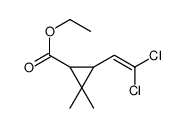
![3.3-二甲基-4.6,6-三氯己烯[5]酸乙酯结构式](https://image.chemsrc.com/caspic/389/59897-92-6.png)
